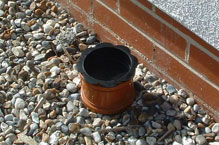Radon and house sales
Radon address search
A report will tell you the estimated probability above the Action Level.
Order a reportRadon measurement pack
Find out the yearly average radon level for a property and if it is above or below the Action Level.
Order a domestic pack Order a workplace packEverything you need to know about radon
Radon is a colourless, odourless radioactive gas formed by the radioactive decay of the small amounts of uranium that occur naturally in all rocks and soils.
The issue of radon comes up when buying and selling properties. Anyone can find out if a property is in a radon Affected Area by completing an online search. The search will tell you the chance of that property having a high radon level.
If you are buying or selling in a radon Affected Area, you may want to consider the following points:
Buyers
- Ask the current owners if they have completed a three month radon test
- If so ask for a copy of the report
- If not, discuss a retention with your solicitor and test when you move in. See Measuring Radon
Sellers in Affected Areas
- If you have previously tested your property, find the result (Contact your test provider if necessary).
- If you have not tested, the new owner will be advised to do so when they move in
- You and your solicitor should be prepared to be asked about a retention.
Retention - what you need to know
- A retention is a sum of money held back from the sale to help with remedial costs
- The typical remediation cost is £1000
- A typical retention sum is between £800 and £3000
- The money is initially held by one of the solicitors for a period of six months, to allow time for moving in, the three month test, analysis and receipt of the report
- If the result is below the Action Level, the money goes to the seller
- If the result is higher, the money pays for remedial works and a timescale is agreed to allow for the works and a further test
- Any surplus money goes to the seller.
A retention may not be suitable when
- The buyers are planning to carry out major building work as soon as they move in
- The buyers are not planning to move in straight away.
Buying a new build home?
When required by building regulations and associated guidance, new build properties in radon Affected Areas are expected to have radon protective measures installed when they are built.
The guidance recommends specific protective measures depending on the construction of the building and whether 'Full' or 'Basic' radon protection should be provided.
You can find out whether you should have full or basic protection by asking your builder or by doing a radon search. The radon search will state whether the radon protection expected is 'basic' or 'full'.
- Basic radon protection - protection is provided by a damp proof membrane modified and extended to form a radon-proof barrier across the ground floor of the building.
- Full radon protection - comprises a radon-proof barrier across the ground floor and provision for subfloor depressurization (a radon sump) or ventilation (a ventilated subfloor void). It is important to realise with full radon protection that the sump is not activated when the house is built. It is capped and available for use as a secondary measure in case the radon-proof barrier is insufficient for reducing radon levels below the Action Level 200 Bq m-3.

The picture shows an example of a typical capped off sump exit pipe.
When you move into your new build home
PHE recommends that you should do a 3 month radon test in your new home during the first year of occupation as it is not guaranteed that your radon level will be less than the Action Level.
If the radon test result is higher than the Action Level and you have full protection built in, the additional measures can be used to reduce radon levels further.
Radon sump
- Activate - add a fan to the sump pipe OR
- Passive - the cap can be removed and a pipe added to above the eaves of the roof
Increased under-floor ventilation
- Add a fan to increase ventilation to the under-floor void
If only basic protection is fitted a radon sump of underfloor ventilation can be fitted - see our guidance on how to reduce radon levels in existing properties.
Once you have made these changes - test again to ensure that the radon levels are reduced sufficiently.
Holiday homes
It is not advisable to test an unoccupied property. If there is a period of three months when it will be occupied, this may provide an opportunity to complete a measurement. It is more important to find out if your permanent residence is within an Affected Area and, if so, test it.
Buy to let
Radon is one of the hazards specified in the Housing Health and Safety Rating System Regulations. For properties in radon Affected Areas a hazard assessment is required. Contact the local council for details.
If you plan to significantly upgrade and/or extend a property in a radon Affected Area, you should seek professional advice. The Building Control or Environmental Health Departments of the local council should be able to help.